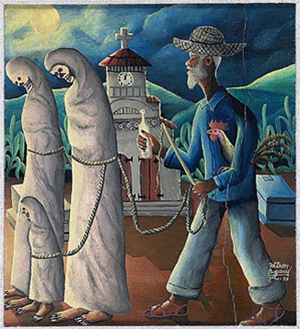Submitted by ARASAllison on
 Lee Weiser takes us by the hand in an exploration of a symbolic image that has seized popular imaginations from around the world for a long time. The newest zombie craze is only the latest in a long standing preoccupation with the archetypal notion of the living dead. The living dead are alive and well in the collective psyche of our times. I first heard this presentation at an International Association of Jungian Scholars conference in Phoenix. Lee Weiser presented with humor and fascination her study of this phenomenon and I was gripped by how alive and timely her presentation was. As students of archetypal, symbolic imagery, every aspect of the human psyche is a potential source of unexpected discovery and vitality, including that which we might think of as “camp” or “low brow”. Clearly, zombies are “low brow”, not “high brow”—in fact they are reduced to primitive drives and instincts without the capacity for higher thought other than
Lee Weiser takes us by the hand in an exploration of a symbolic image that has seized popular imaginations from around the world for a long time. The newest zombie craze is only the latest in a long standing preoccupation with the archetypal notion of the living dead. The living dead are alive and well in the collective psyche of our times. I first heard this presentation at an International Association of Jungian Scholars conference in Phoenix. Lee Weiser presented with humor and fascination her study of this phenomenon and I was gripped by how alive and timely her presentation was. As students of archetypal, symbolic imagery, every aspect of the human psyche is a potential source of unexpected discovery and vitality, including that which we might think of as “camp” or “low brow”. Clearly, zombies are “low brow”, not “high brow”—in fact they are reduced to primitive drives and instincts without the capacity for higher thought other than
how to perpetuate and increase their own. At times, that sounds like the human species itself. This paper offers us the opportunity to explore the zombie phenomenon as an archetype.
-Tom Singer
Books, newspapers, TV, websites, radio shows, social networks, and the Center for Disease Control have now managed to alert the entire country to the threat of a possible zombie apocalypse. Instead of creating mass panic, reports of the walking dead have evolved into immeasurably popular sources of entertainment and zombies themselves have displayed an amazing versatility as metaphors for such diverse elements as the evils of racism, consumerism, conformity, and vivisection; the Viet Nam war; social apathy; loss of individuality and identity; fascism; industrial dystopia, ecological disasters; immigration, diseases, plagues, and pandemics; spiritual bankruptcy; and the TEOTWAWKI (what “preppers” call “the end of the world as we know it”). Something about these moaning, brain-dead beings who move in swarms but don’t move right, act right, talk right, eat right, or behave right has captured the collective cultural imagination and generated endless speculation about their condition and the condition of the world in which they lumber.
It might seem at first glance that these popular but unrealistic rotting roamers are just a recent product of postmodern subtexts, but a longer look unearths the fact that written accounts of reanimated corpses have been turning up since people first pushed wedge shapes into clay tablets. When the Sumerian goddess, Ishtar, didn't get her way, she threw an epic fit of anger and threatened to release the dead from the Netherworld to consume the living (ca. 911-612 B.C.E.). The Hebrew prophet, Ezekiel, stood by as a witness while his Sovereign Lord raised an entire army from dry bones that had been lying scattered in a valley (Ezekiel, 31, 1-14). From Osiris to Dionysus, Balder to Quetzalcoatl, mythology from around the world is rife with the motif of dying gods and goddesses who come back to life.
Read Zombies: A Brief Natural History in its entirety.